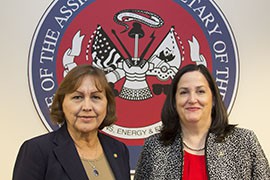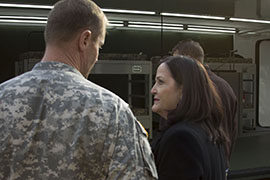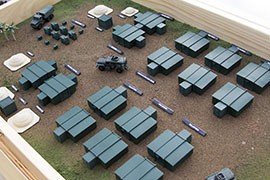Cronkite News has moved to a new home at cronkitenews.azpbs.org. Use this site to search archives from 2011 to May 2015. You can search the new site for current stories.
Two Arizonans among growing number of women leaders in the Pentagon
WASHINGTON – When developers boasted during a recent demonstration in the Pentagon courtyard that their portable, rigid-walled shelter could be set up at a forward base in 15 minutes, Katherine Hammack called them on it.
“I’m starting the timer now,” she called to the team of camouflage-clad soldiers demonstrating the shelters.
When Hammack speaks, soldiers listen.
That’s because Hammack is an assistant secretary for the Army, one of two Arizonans in the top echelon of its civilian leadership, just below the secretary and under secretary of the Army.
What’s more striking is that both Arizonans are women in the male-dominated world of the military. Both Hammack, the assistant secretary for installations, energy and environment, and Mary Sally Matiella, the assitant secretary for financial management and comptroller, have been in their positions since 2010.
The number of women in leadership in the military has grown in recent years, said Michele Flournoy, who was the highest ranking woman at the Pentagon from 2009 to 2012 when she served as under secretary of defense for policy.
“When I was there in the ’90s (as an assistant secretary), we had a women’s leadership lunch and all eight of us sat down at one table,” Flournoy said as she stood in a large Washington conference room this week. “Now, you would overflow this room if you brought all of the women leaders together.”
Being in a career field that is not traditional for women is nothing new for Hammack, who earned a degree in mechanical engineering at Oregon State University. She said only about 5 percent of mechanical engineers are women.
That career brought her to Arizona where she spent six years at Arizona Public Service, working in the areas of high-performance buildings and energy efficiency. She spent another nine years at Ernst & Young’s climate change and sustainability services practice in Phoenix, where she was working when her country called in 2010.
“I got a call from the White House essentially saying, ‘Your country needs you, we need you to bring this kind of science, technology, energy and environmental focus to the Army,’” Hammack said. “It’s bringing things that maybe are a little bit more of habit (in Arizona).”
Hammack, a founding member of the U.S. Green Building Council, said her time in Arizona helped prepare her for her current job, where she is responsible for the Army’s infrastructure, sustainability efforts and resource management. It’s a role that she said is informed by her experience in the private-sector providing energy and sustainability advisory services.
“There is a respect for the environment that’s just part of the Arizona culture,” said Hammack, who helped start the U.S. Green Building Council chapter in Phoenix. “Those are things that I think I was able to bring here that directly fall in line with some of the Army values.”
While Hammack was being plucked from the private sector in 2010, fellow Arizonan Matiella was tapped for political appointment to her position after spending her whole career in government service. Much of that time was spent as an accountant with the Defense Department.
She said that as a federal worker she has always felt a special responsibility to the folks she knew back home in Tucson.
“I was always very, very mindful of how responsible we have to be with the use of our federal dollars, because people are working very hard … and they’re struggling to make ends meet,” Matiella said.
Matiella’s family moved to Arizona when she was 6 weeks old, and when she was 8 they moved to Tucson, where she earned bachelor’s and master’s degrees at the University of Arizona. It was also in Tucson where she got her first job, at age 16, working on Davis-Monthan Air Force Base during the Vietnam War.
It was there that she not only met her future husband, Francisco Matiella, who was serving in the Air Force, but she began her lifelong relationship with the military.
“I fell in love with the Department of Defense,” Matiella said. “People were … putting their life on the line for the values that the United States has.”
The wife of a career Air Force officer, she needed a “flexible” career that let her relocate every few years. Working for the government meant her career continued to advance despite the frequent moves.
“Little by little, eventually, it is such a fair institution, there’s so much diversity here and it’s so fair that if you work hard … you eventually go up the ladder,” Matiella said. “The Department of Defense really values hard work and as a consequence, diversity can really flourish here.”
The Office of Personnel Management says women make up a little more than one-third of the civilian workforce at the Defense Department, about 3 percent lower than it was in 1998. But in the Office of the Secretary of the Army, however, the number of women has grown by 47 percent over the same period.
There are still Pentagon leadership meetings with few women present, but “it’s changing,” said Flournoy, a member of Women in International Security. The group works to boost the number of women in leadership positions.
“The key sign for me was when there’s a nickname developed for women in the Pentagon, you know you’ve arrived – there’s enough of a critical mass,” Flournoy said. “So we were the ‘clackers’ because of the noise your heels make on the linoleum floor.”









